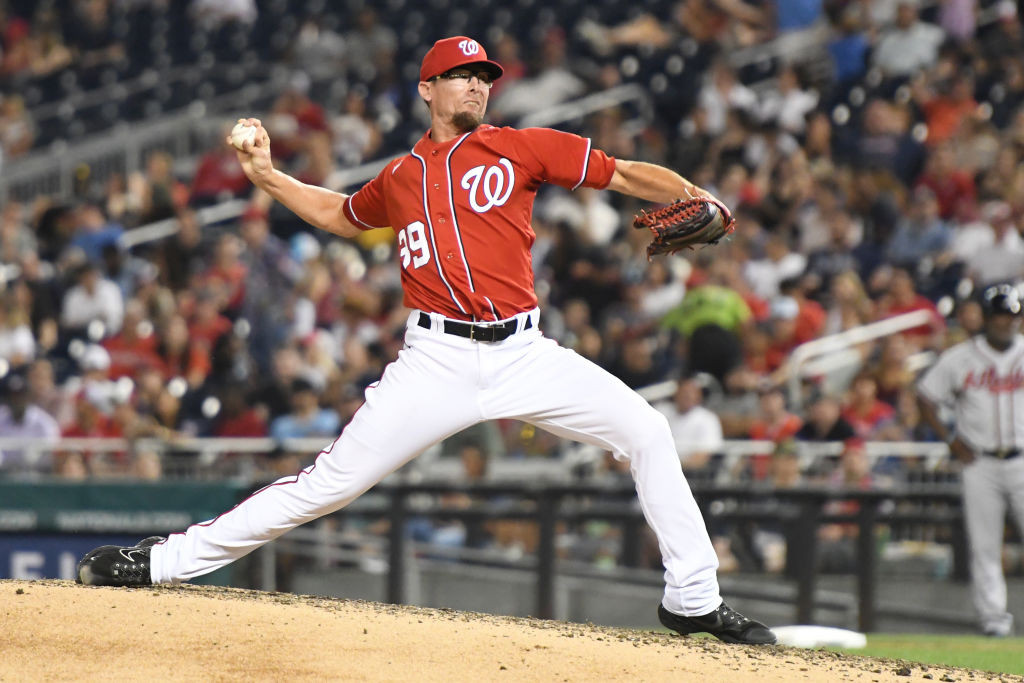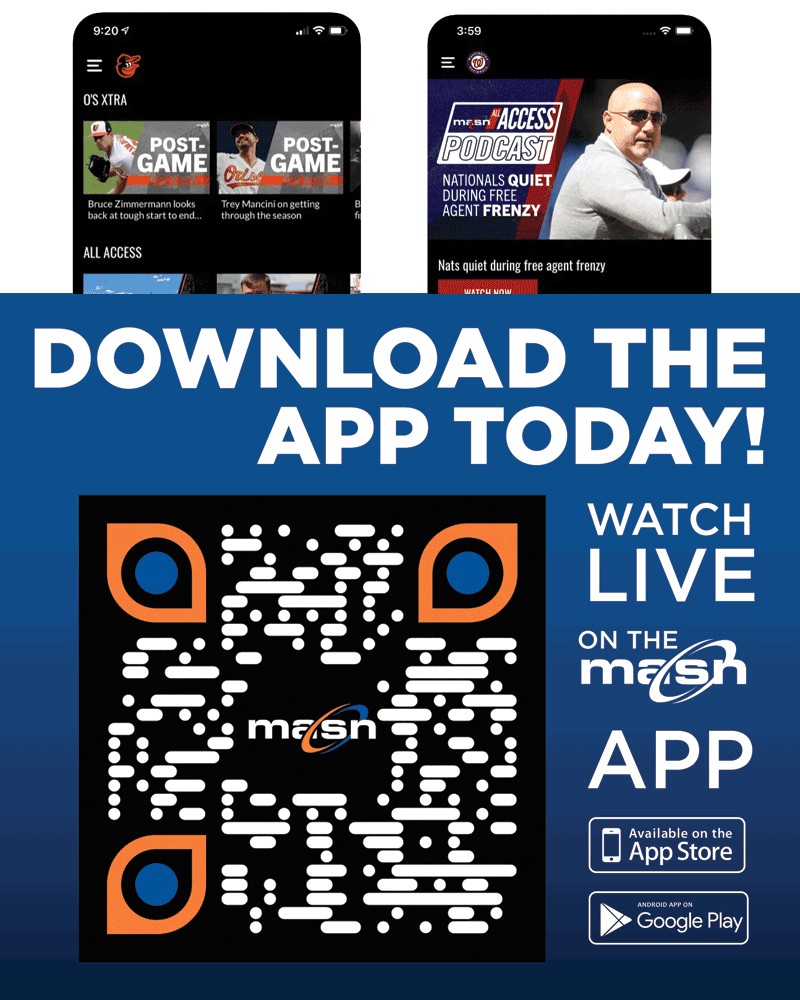The Nationals recently announced plans for their 20th anniversary celebration in 2025, with a number of special events and giveaways promised, not to mention a ranking of the 20 greatest moments in club history.
We here were already planning our own 20th anniversary celebration, and why wait until 2025 to get started with that? The Nats already have completed 20 full seasons in D.C., so this is as good a time as any to get the ball rolling with a weekly series that will run every Sunday through the rest of December: The 20 Greatest Players in Nationals History.
What constitutes “greatness?” For these purposes, we’re considering a combination of quantity and quality, plus impact on and off the field. Some of these guys played many years here and had lots of time to make names for themselves. Some of them weren’t here very long but still made a difference with specific acts of greatness.
We only considered a player’s contributions for the Nationals at the major league level. It doesn’t matter what they did before or after they were in Washington. No one singular stat was deemed more important than any other. Postseason performance wasn’t required, but it certainly elevated some players’ cases for inclusion on this list. This is, to be clear, a subjective exercise. There’s no right answer. And that means there will surely be some healthy debate about the choices, which is how these things are supposed to be.
We’ll unveil five names each week, culminating with the top five on Dec. 29. And with that, we begin today with No. 16-20 …
NO. 20 – HOWIE KENDRICK
Infielder/Outfielder, 2017-20
Stats: 238 G, 808 PA, 741 AB, 113 R, 234 H, 49 2B, 3 3B, 30 HR, 113 RBI, 7 SB, 4 CS, 50 BB, 133 SO, .316 AVG, .361 OBP, .511 SLG, .873 OPS, 125 OPS+, 3.1 bWAR, 4.0 fWAR
Kendrick didn’t actually play that much for the Nationals; he’s 43rd in club history in games played. Acquired at the trade deadline in July 2017, he was a bench player that first year, then missed most of the 2018 season after rupturing his Achillies’ tendon (an injury that opened the door for Juan Soto to make his big league debut the next day). And injuries hampered him again during the pandemic-shortened 2020 season, ultimately leading to his retirement.
But let’s be clear: Kendrick deserves to make this list because of what he did in 2019. And it wasn’t just the postseason. He batted a rousing .344 during the regular season (second-highest of any player in club history who took at least 350 plate appearances) with a .966 OPS (sixth-highest in club history). He forced his way into Davey Martinez’s October plans, and then he forever etched his place in franchise lore with a postseason for the ages. The 10th-inning grand slam to win Game 5 of the National League Division Series. Four doubles and four RBIs in four games to win National League Championship Series MVP honors. And of course the clang heard round the world with his go-ahead homer off the foul pole in Game 7 of the World Series.
Does that legendary October make Kendrick worthy of a spot higher on this list? Maybe. But his total contributions during his Nationals career don’t really stack up with everyone else in the Top 20. So let’s just celebrate what he did do when it mattered most and know his place in franchise history is secure.
NO. 19 – TYLER CLIPPARD
Relief Pitcher, 2008-14, 2022
Stats: 34-24, 2.72 ERA, 418 G, 34 SV, 469 IP, 310 H, 153 R, 142 ER, 52 HR, 186 BB, 534 SO, 145 ERA+, 1.058 WHIP, 10.0 bWAR, 6.0 fWAR
Who’s the greatest reliever in Nats history? The short list would include several closers, including Chad Cordero, Sean Doolittle and Drew Storen. But there’s a strong case to be made that the guy who was around a lot longer than any of them while mostly serving as a setup man was the best of the bunch.
Nobody has pitched in more games as a National than Clippard. Nobody who pitched at least 200 innings for the club owns a lower career ERA (Cordero is second, Max Scherzer is third). Only Scherzer (0.962) has a lower WHIP while wearing a curly W cap.
The best relievers often were failed starters, and sure enough that’s what Clippard was. Acquired by Jim Bowden in December 2007 from the Yankees for the forgettable Jonathan Albaladejo, Clippard was a mediocre Triple-A starter in 2008 before getting moved to the bullpen in 2009. He wound up spending parts of 16 seasons in the big leagues, frequently moving from one franchise to another but always displaying a combination of effectiveness and durability so rare at his position.
He wound up spending more than half his career with the Nationals, though, including one last stint in 2022 that, unfortunately, didn’t go so well. No matter, because Clippard’s contributions from 2009-14 stack up with any sustained pitching performance in club history and make him a worthy member of this esteemed list.
NO. 18 – ALFONSO SORIANO
Outfielder, 2006
Stats: 159 G, 728 PA, 647 AB, 119 R, 179 H, 41 2B, 2 3B, 46 HR, 95 RBI, 41 SB, 17 CS, 67 BB, 160 SO, .277 AVG, .351 OBP, .560 SLG, .911 OPS, 135 OPS+, 6.1 bWAR, 5.4 fWAR
Everybody in our Top 20 played at least three seasons for the Nationals … except for Soriano, who of course only spent one year here. But what a year it was. Before Shohei Ohtani destroyed every record in the book, the 40-40 Club was a huge deal. And when Soriano joined that club in 2006 (while also totaling 41 doubles, by the way), it was major news not only in Washington but throughout the baseball world.
Soriano’s acquisition from the Rangers at the 2005 Winter Meetings was controversial at the time. Bowden gave up three players (Brad Wilkerson, Terrmel Sledge, Armando Galarraga) for an All-Star player who was going to be a free agent after only one season. And Soriano had been a second baseman his entire career, but the Nationals already had established veteran Jose Vidro locked in there, forcing Soriano to left field. He didn’t initially take kindly to that transition, refusing to take the field for his spring training debut before finally accepting his fate the next day.
Not that his rocky arrival had any negative impact on his ultimate performance. Soriano was great from Opening Day on, unburdened by RFK Stadium’s monstrous power alleys while mashing 46 home runs (still a single-season club record to this day). And while all the attention was on his power-speed combo, let’s not forget he also still owns the club record for runs scored (119) and outfield assists (22).
Soriano did all this for a losing team, so his was one of the hottest names to come up at the 2006 trade deadline. Bowden, though, bucked conventional wisdom and kept him through season’s end, believing the draft pick compensation the team would get if he left as a free agent was worth more than any prospects being offered by other clubs. Soriano wound up signing with the Cubs for $136 million; the Nationals wound up with a compensatory draft pick named Jordan Zimmermann.
NO. 17 – ADAM LaROCHE
First baseman, 2011-14
Stats: 489 G, 2,000 PA, 1,727 AB, 234 R, 430 H, 77 2B, 4 3B, 82 HR, 269 RBI, 9 SB, 2 CS, 246 BB, 414 SO, .249 AVG, .341 OBP, .441 SLG, .781 OPS, 112 OPS+, 7.0 bWAR, 5.6 fWAR
Mike Rizzo’s biggest free agent signing prior to the 2011 season was Jayson Werth, who got $126 million over seven years to help turn a losing franchise into a winning one. The signing of LaRoche for a modest two years and $15 million didn’t draw nearly as much attention. But in the end, it was one of the most important signings in club history.
Like Werth, LaRoche struggled in his first season in D.C., making plenty worry if he was a bust. He bounced back in a big way in 2012, though, with one of the great single seasons in team history: 35 doubles, 33 homers, 100 RBIs, a Silver Slugger Award, a Gold Glove Award and a sixth-place finish in NL MVP voting.
LaRoche parlayed that performance into another two-year deal with the Nats, this time for $24 million. He never duplicated his 2012 numbers, but he still launched 26 homers with 92 RBIs in 2014 while continuing to play smooth defense and providing soft-spoken but crucial veteran leadership in the clubhouse.
The Nationals would’ve happily brought LaRoche back in 2015, and he would’ve happily stayed. But Ryan Zimmerman’s shoulder woes mandated a permanent switch to first base, and so LaRoche was squeezed out. He signed with the White Sox, where he struggled for one season before shockingly retiring when the organization said his son, Drake, was no longer welcome in the clubhouse. (Drake was beloved by the Nats.)
NO. 16 – DANIEL MURPHY
Second baseman, 2016-18
Stats: 342 G, 1,380 PA, 1,255 AB, 199 R, 413 H, 99 2B, 8 3B, 54 HR, 226 RBI, 8 SB, 3 CS, 100 BB, 151 SO, .329 AVG, .380 OBP, .550 SLG, .930 OPS, 139 OPS+, 7.2 bWAR, 8.6 fWAR
Murphy didn’t do much else beside hit, but boy did he hit. He’s arguably the best pure hitter the Nationals have ever employed, combining elite bat-to-ball skills with pull-side power that made him one of the first great products of the “Launch Angle Revolution.”
Murphy burst onto the national scene with an epic performance for the Mets in the 2015 postseason. And when New York opted not to bring him back, the Nats swooped in and gave him a three-year, $37.5 million deal that proved to be a steal. He led the league in doubles, slugging and OPS in 2016, finishing runner-up to Kris Bryant for NL MVP. And he nearly duplicated those numbers in 2017, leading the Nationals to a second straight division title.
But during the NLDS, Murphy hurt his right knee and required offseason surgery. Recovery from that procedure proved far more difficult than anyone envisioned, and sadly, he was never the same guy. The Nats dealt him to the Cubs in August 2018, and he finished his career with two nondescript seasons in Colorado.
All told, Murphy played 12 seasons in the majors, seven of those with the Mets, the franchise he most identifies with. But he never put up offensive numbers anywhere like he did in Washington. Hardly anyone has. Among all players in club history with at least 500 plate appearances, he’s No. 1 in batting average, No. 5 in on-base percentage and No. 2 in both slugging percentage and OPS.
By accepting you will be accessing a service provided by a third-party external to https://www.masnsports.com/





